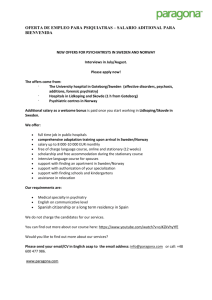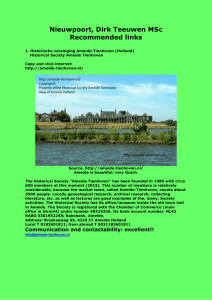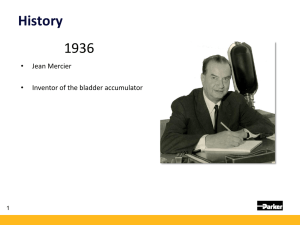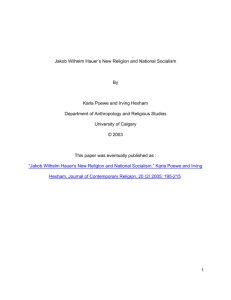TZD: Lessons Learned from Other Countries
advertisement
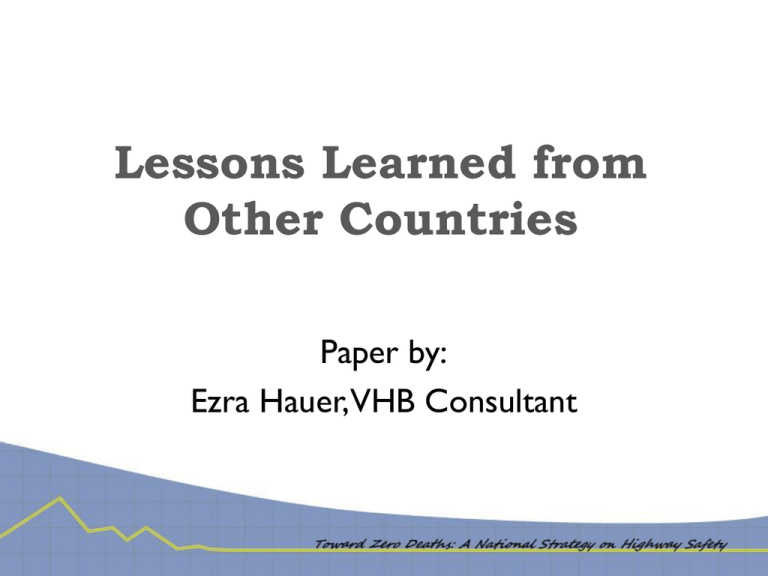
Lessons Learned from Other Countries Paper by: Ezra Hauer,VHB Consultant Warnings Interpretation of time series: All that glitters is not gold Not every change in a time series of fatalities is due to the most recent intervention Fatality “mountain” is natural Effect of rising travel and declining risk per mile History France First fatality-reduction goal in 1997, but no change in programs Major political “shift” in 2002 with new programs France -- Lessons Public support for safety changed, quickly followed by change in highest level political will – good timing! President Chirac had public support, made safety an issue, and had functioning government machinery to act intelligently and with resolve. Not clear whether safety researchers were involved in decisions, but facts developed shaped public debate and therefore politics No infrastructure initiatives – but probably because chosen behavioral programs pay for themselves France – Lessons (cont) Seat belts and helmets work (but had already been emphasized) 99% percent usage Speed enforcement is important and works, particularly if automatic! In 2005, each driver monitored 7 times per month Average speed of passenger cars decreased from 82.2 km/hr to 80.4 km/hr (2006 to 2008) Percent above speed limit – 42.9% to 32.3% Percent 10 km/hr above limit – 16.7% to 10.9% Norway History Vision Zero part of National Transport Plan 2002-2011 VZ interpretation: Not likely to reach zero fatalities or serious injuries but should see continuous reduction toward zero By 2020, reduce number of fatalities and serious injuries by at least one-third as compared with 2005-2008. Norway Norway – Lessons Safety as part of National Transport Plan Safety takes natural role as cost of mobility, not as independent or overriding goal Land use, transport and safety plans should be developed together – integration Hauer – don’t confine search to “new programs/actions”, but ask how prevailing arrangement need to be modified E.g., attention paid to rural vs. urban safety Norway – Lessons Quantitative safety targets? Norway has speed limit compliance, seat belt use and bicycle helmet use 2020 targets Positives Communicates importance of safety, motivates stakeholders, holds managers accountable, shows government is serious Negatives No clear evidence they matter in success Difficult to predict “baseline without change” -- what would happen in future with current policies Possible dangers to safety programs of perceived failure Conclusion Overall quantitative target may not be necessary, but actions that bring about change is Measures to be changed should be carefully chosen based on benefits and costs. Sweden History 1994: New Minister for Transportation declared safety as priority 1997: Bill on Traffic Safety included “Vision Zero means that eventually no one will be killed or seriously injured within the road traffic system.” 2007: Initial goal not met (i.e., 50% fatal reduction), so new goals and objectives set Management by objective – new interim “action” goals and annual analysis and conference E.g. – Speeds, driver BAC, belt use, helmet use Sweden History Sweden – Lessons Shift from “blame the user” to “producer is responsible for safety of the product” New allocation of responsibility Designers of system are responsible for design, operation and use, and thus safety of system Users are responsible for following rules of use But if user fails and injuries occur, system designers must take necessary steps to reduce harm Sweden – Lessons Based on simple rules (most related to speed) Pedestrians not exposed to cars > 30 km/hr Car occupants not exposed to right angle collisions with cars exceeding 50 km/hr or head-on with cars exceeding 70 km/hr Etc. These rules then lead to policies on speed limits, roundabout use, barriers, etc. Sweden – Lessons Paradigm shift for U.S. From benefit/cost analysis to “whatever it takes to reduce fatalities” From limited attention on speed enforcement to speed management and design changes To infrastructure changes based on speed “rules” (e.g., separation of high-speed two-lane roads to “2+1” design concept) So do we need TZD or just better benefit/cost based planning? Holland History 1987: First long-term safety plan – traditional treatments/countermeasures, 50% fatal reduction by 2010 1996: Plan modified to include “Sustainable Safety” – leave inherently safe road environment for future generations Still more emphasis on B/C analysis than in Vision Zero 1998-2002: First wave of programs Major change – lots more km classified for lower speed limits 9.7% reduction in fatalities and 4.1% in severe injuries 2008: New 2020 plan places more emphasis on behavioral treatments paid for by the violator Holland History Holland – Lessons Wide-spread support for SS, but implementation seems to have stalled. Why? Concept coined by scientists – but decisions by politicians and they change over time For long-term TZD success, must have support of both US parties Continue use of BC analysis as kingpin – parties can change both acceptable ratio and value of life For long-term TZD success, must rely on and thus train road professionals in safety (planners, designers, traffic engineers, others) Holland – Lessons Must decide which generation will pay for major changes in system – ours or future ones Look to environmental debate Dutch emphasis on safety in residential areas and urban areas – will we shift to do the same? Holland – Lessons Independent research institute (SWOV) is instrumental in Holland success due to influence on policy. SWOV is grant funded and has internal control of its programs US has no independent institutes – all dependent on contracts with topics chosen by others. No long-term grants. Prestige and knowledge of US institutes are not well used. US model may be due to commitment to laissez faire competition, but attraction may be in that it gives funders control over questions asked and, to some extent, advise given. His conclusion: As demonstrated by SWOV, there is another model for consideration. UK History UK has long, strong history of safety programs E.g., driver licensing, roundabouts, safety engineer training, mandatory safety audits, etc. 1987: First numerical goal – 33% casualty reduction by 2000. Had 39% fatality and 45% serious casualty reductions by 1998 2000: New goals for 2010 (e.g., 40% fatal/serious injury reduction, 50% child fatal/serious injury, etc.) 10 themes with progress review each 3 years (but really done annually) UK History UK History 2009: First mention of “vision” – “safety roads in the world” (i.e., better than Sweden and Holland re fatalities/100k population). “A vision is not a substitute for safety strategy” New goals for 2020 (e.g., 33% fatal reduction, 50 percent reduction in ped and bike KSI rates) 13 “Key Performance Indicators” UK – Lessons No new “breakthroughs” Continued reliance on cost-effective treatments perhaps with some new measures (e.g., lower speed limits on two-lane rural roads) Continued reliance on professionalism and cooperation between research, civil service and elected representatives No Zero Death vision Achieving target no longer taken for granted and new approaches might be needed in Netherlands and Sweden Intensified application of existing measures thought to be sufficient in UK Where is US UK – Lessons Setting targets and monitoring progress is challenging and requires resources Must predict what would be the case in the future under current program (baseline), which is difficult Must define cost-effective program of initiatives and predict its impact Must set up system for monitoring progress UK – Lessons In UK, safety had to fit between poles of increased mobility and improved environment If US road safety is to be elevated and based on BC basis, estimates of dollar value of time and life need to be re-examined TZD allies are more likely to be in environmental camp than in mobility camp Both transportation planner and traffic engineers are primarily mobility oriented Must find out what needs to be changed to make them friends of TZD Questions?
